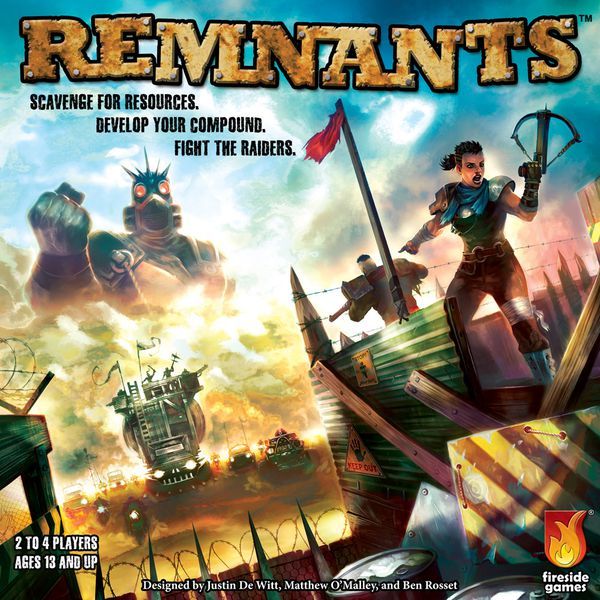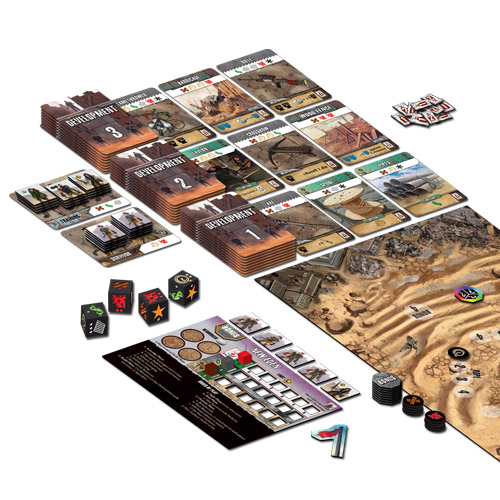Remnants: A Post-Apocalyptic Survival Game by Fireside Games

Survivors are counting on you. Can you protect your settlement, drive back raiders, and create a home in a post-apocalyptic landscape?
Remnants will have players vying for control of limited resources in a game that blends real time dice rolling with resource management.
Gameplay
Each player takes a player board that represents their settlement and takes the starting survivors that go with that particular settlement. Some survivors have special skills: the scrounger can claim resources with fewer dice results, the hauler can carry two items, and the rummager earns more loot.
The main game board is set up. There are four resources and a certain number of each are placed on the board based on the number of players. A certain number of bonus tokens are also placed on the board based on the number of players. Development cards, which players will spend resources to buy, come in three different levels. Three cards are drawn from each of the three decks of development cards. Whenever one of these cards is bought, it is immediately replaced. The dread deck is built with random enemies of various difficulty levels and a boss, and the game begins.
At the start of each round, players choose how many of their survivors they will send to loot the cities and how many will be sent to scavenge for resources in the desert. Once each player has decided, you flip over a badlands card. The badlands will affect the survivors going out into the desert. It may injure some, send a certain number back to their settlements, or even earn you extra loot.
Next comes the real time portion of the game. Each player starts rolling their four dice. You may roll as many times as you wish, and may reroll as many dice as you like. When you have three dice showing the same resource, you may choose to call out that resource and claim it, moving it onto one of your survivors. Each survivor (except the hauler) may only carry one item. You may keep rolling after you have already claimed a resource. If you roll three stars, you may choose to use them to claim a bonus token, after which you may not roll again. After the last bonus token is taken from the board this phase ends and all players must stop rolling. Bonus tokens may be spent during the round to give you various advantages and bonuses (such as earning more loot or claiming an extra resource).
Players then roll one die for each survivor that is looting in the city. Each face of the die has one or more pips on it. You earn one loot point for each pip you roll. There are three types of loot and you may choose how to distribute your loot points between these three. There are meds; you may spend med points to heal survivors at the end of the round (if an already injured survivor is injured a second time, it dies). There are tools; you may spend two of these to reroll a die. And there is scrap, for which two may be spent in lieu of any one resource.
Next is the development phase in which players take turns spending resources to buy development cards and recruit new survivors or train current survivors in one of the three special survivor skills. Every other turn, after the development phase, there is the fight phase when a threat on the current dread card attacks. Each player will have to resolve the attack separately with the enemy at full health each time. You remove health from the target for each defense point granted you by your development cards, and then roll one die for each attack point you have from your cards. You add up the pips on your roll and subtract that total from the enemy’s health. Each enemy has a reward for defeating it and a penalty for failing.
At the end of six rounds, the boss dread card is drawn with a random special ability card. After each player has resolved their fight against the boss, the game ends and people calculate their scores. You add all points shown on the development cards you’ve bought and the victory point tokens you’re earned and add points for uninjured survivors in your settlement. The player with the most points wins.

Review
Real time dice rolling and resource management is an unusual combination, but Remnants brings them together like peanut butter and jelly. The dice rolling nicely captures the feeling of chasing down limited resources and pitting players against one another. It keeps things tense without infusing the game with take-that elements.
There’s a lot of theme in the game and the theme and mechanics complement each other nicely. It feels great to build up your compound and slowly get the sense of being on firmer footing as the game proceeds and your settlement takes shape.
The game has a lot of roads to victory, which means you can adjust your plans if the cards you’re after get taken by other players. Remnants is certainly difficult in some regards — fighting the dread cards is challenging and there’s a lot of luck involved in whether or not you defeat the attackers. But victory is not contingent on defeating them, and that difficulty feels appropriate for the game and its theme.
Some of the symbols on the cards are not intuitive, and you’ll be referencing the rulebook regularly when you first start playing; however Fireside Games always has excellent rulebooks and Remnants is no exception. Everything is clear, concisely, and laid out logically.
A lot of elements come together to make Remnants tough and enjoyable. The components and artwork are top notch, the theme is expertly woven throughout all aspects of the game, and the mechanics blend together nicely.
Pros: Thematic and challenging, nice component quality, excellent rulebook
Cons: Some of the symbols are not clear
Disclosure: we received a complimentary review copy of this game.







